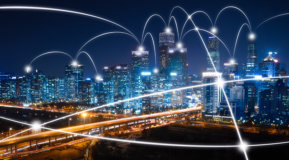
While the world is dealing with the worst health and economic crisis of the past century, there’s been a subtle shift in the public narrative. We’ve moved from the shock of the pandemic to thinking about how to ease back to some sense of normalcy with a phased approach to reopening economies. But if you’re a business owner, how do you prepare for recovery?
One thing is certain: It’s unlikely we’ll all head back to work at the same time. And even when we do, our physical workplaces will look different. How will we reconfigure office buildings to maintain social distancing while ensuring productivity? And what about the schools that educate our children? What will learning look like in our near-future? These are all things we will need to consider as we shift into recovery mode.
At Aruba, we have begun talking to customers and community leaders about these challenges. I wanted to share our thoughts on things to consider as we emerge from this global business disruption. And, of course, we will be discussing these topics at ATM Digital, our free event for our community of customers, partners, and networking influencers, so you can dive deeper with us there.
1. Workforces will continue to work remotely.
Several large companies—including HPE—have said that while businesses begin to ease back to normalcy, they will not require team members to return to the physical office. In an article with CRN, Antonio Neri, CEO of HPE, said, “Our work-from-home guidance will not be lifted just because government orders are removed; we will only reopen sites when we feel we are in the best position to welcome back team members safely. We will modify our sites to ensure physical distancing can be maintained, and we won’t all return at once. Most importantly, returning to the office will be voluntary.” These words echo sentiments across the global business community, which means that remote work is here to stay—at least for a while.
As the home becomes the primary place where mission-critical work gets done, organizations have to adapt their IT postures to account for this new reality. The edge of the enterprise footprint gets even more distributed giving rise to new concerns around security, visibility and user experience. Should IT provide the tools for work at home? What should those tools be? Is it simply a laptop and a set of cloud/web applications or is it more? Does it include connectivity, security, and application assurance for carrying out mission-critical work? Many Aruba customers have chosen to not only provide the computing environment, but a secure networking environment at home so employees get the same network experience as they do at their workplace. No need to VPN in to work, so to speak. Simply turn on your device and start using it like you naturally do at work. The connectivity and security are taken care of for you just like it is at work. Also, IT gets to have visibility into this remote work environment in order to troubleshoot, maintain and monitor for security compliance.
2. Rise of the automated edge.
As the Edge footprint increases, our ability to reach out and touch it has vastly diminished. All due to COVID-19. Everything at the Edge must be done remotely from an IT standpoint, which means Edge infrastructures at homes, branches, stores, warehouses, or other places will all need to be deployed and managed in a zero-touch manner. This means everything must be instrumented for automation and remote management. Cloud-managed solutions with advanced AIOps capabilities will play a large role in how these distributed environments will be deployed and managed.
3. Healthcare capabilities become part of the business recovery mix.
While the world’s leading researchers race to uncover a vaccine, governments realize that the key to recovery is an increase in COVID-19 testing. The ability to test, track contacts, and quarantine those infected hinges on the ability to test large numbers of the population. As the healthcare community continues to shift with these changing priorities, we will continue to support them with Rapid Response healthcare solutions that allow secure connectivity. Whether they are planning for pop-up testing, a triage tent, or a makeshift hospital in a stadium to prepare for a surge in patients, Aruba will be there to help.
4. Education shifts to a hybrid model.
As we speak to customers in the education space, their challenges start to sound similar to those of enterprise business customers: How do we bring students back to physical locations while maintaining social distancing? How do we engage students when online learning stretches into an extended timeframe? And what are the resulting implications in how educators and planners prepare their education and technology plans to support these new learning models?
Aruba will continue to support our education customers and partners as they navigate these challenging times. We’re here to help them configure their network infrastructure to get the most from the collaboration solutions they choose – whether Teams, Zoom, or something else.
5. Supply chains become a key differentiator.
Aruba has done well in our supply chain execution and it is due to the resiliency we implemented across our supply chain plans. As the pandemic leaves behind a trail of disruption, everyone will evaluate how they can plan for more resilient supply chains that can withstand future pandemics or similar global disruptions like this one.
As we begin to navigate COVID-19 recovery efforts, I continue to be humbled by the response from our employees, customers, and partners who have stood together to support their communities.
- We were overwhelmed by the tremendous response we received with our Airheads Volunteer Corps, an opt-in registry of volunteer network engineers ready to assist in the build out of network infrastructures for medical facilities battling this pandemic and caring for the surge of patients.
- When Italy was at the height of the pandemic, Aruba partnered with Grandi Navi Veloci (GNV), MSC Cruises, and others to convert the GNV Splendid, a large passenger ferry, into a floating hospital, providing Wi-Fi coverage for healthcare workers and patients across the various decks.
- And our partnership with the San Antonio Spurs and AT&T allowed us to transform the Spurs’ stadium parking lot into a free drive-in Wi-Fi hotspot, ensuring children with limited connectivity at home have access to online distance-learning resources.
These are just some examples of the power of the Aruba community and partnerships, where everyone came together to make a very real difference. We have stood together during this pandemic, and we will overcome it together as we move from the battle to recovery.
Read about Business Continuity and how Aruba is helping
Serving our Communities Together in the Midst of a Pandemic
Establishing Calm in the Face of Chaos
Ingenious Overflow Facility Answers COVID-19 Response Needs
HPE Aruba supplies network infrastructure to floating hospital to aid COVID-19 patients in Italy
Read how HPE is helping customers with flexible financing
HPE rolls out extensive financial relief and support initiatives for partners impacted by COVID-19




